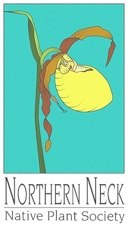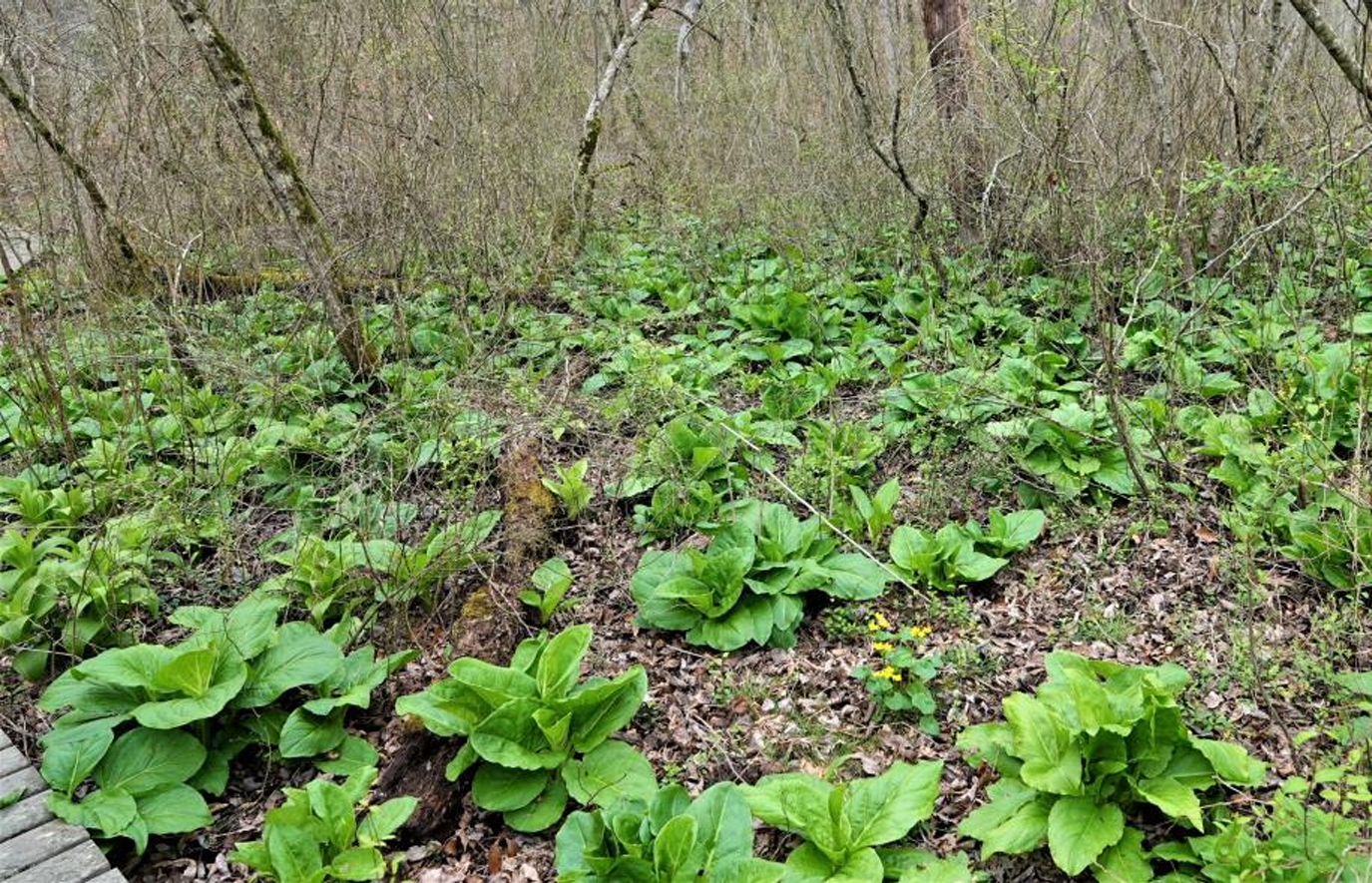Re-Post: December 2020 Plant of the Month: Skunk Cabbage, Symplocarpus foetidus
By Betsy Washington
As the winter solstice approaches, I am already anticipating the blooms of our earliest spring wildflower, Skunk Cabbage, Symplocarpus foetidus. The buds of this winter blooming wildflower begin to appear in our region as early as the beginning of December and the flowers often are in full bloom by New Year’s Day. As one might imagine for a wildflower that manages to bloom and attract pollinators in the dead of winter, this plant has developed some remarkably interesting adaptations to the cold and even snow cover.
Like Jack in the Pulpit, Skunk Cabbage is a member of the Arum family with an unusual flower structure of tiny flowers borne on a club or spike-like structure called a spadix. Often the club is partially enclosed by a colorful leaf-like structure called a spathe. In the case of Skunk Cabbage, the flowers emerge and bloom before the leaves open beginning around or before New Year’s Day. The spathe is a smooth fleshy hood and is a deep burgundy-purplish color, often with greenish mottling. Some say it resembles carrion as the plant emerges from the snow or frozen ground. The spathe is about 4 – 6” long with a pointed tip and a small opening on one side, and partially surrounds the actual flowering structure inside. The spadix is knob-like and divided into raised bumps each of which bears a tiny flower. The tiny flowers are only ¼” wide and have no petals. Instead, the plants have unique adaptations that allow them to emerge through snow and attract pollinators. The plant can generate heat and raise temperatures inside the spathe as high as 77 degrees even when temperatures outside are below freezing.
As you might imagine with a common name like skunk cabbage, and a scientific name like foetidus (Latin for fetid smelling), the bruised leaves and flowers of skunk cabbage have a putrid odor. Some say it resembles a skunk, while others describe it as smelling like a long dead animal but fortunately you have to stick you nose up close to detect the fetid odor. This is quite an adaptation as the chief pollinators of the stinky flowers appear to be carrion flies, blow flies and flesh flies that are attracted to the seemingly decomposing-flesh-like odor, but research is on-going. Besides the “alluring” smell, the warmth inside the spathe, entices insects in to lay their eggs thereby incidentally pollinating some of the flowers. Once pollinated, the spadix enlarges into a compound fruit with a blocky surface somewhat like a miniature pineapple. Each berry-like fruit contains a single seed, which ripens and falls to the ground near the Mother plant to potentially create a colony of skunk cabbages.
Skunk cabbages are long-lived and have massive roots with a stout rhizome that extends deep in the soil surrounded by large masses of fibrous roots. The wrinkled roots are contractile, meaning that they contract and pull the plant down a few centimeters deeper in the soil each year, so that the flowers are always at or partly below ground level. These large roots also store the energy required to raise the temperature of the flowers each winter.
Once the plants have bloomed, the leaves unfurl, and eventually grow into a showy vase-shaped mounds of large, lush foliage, with wrinkled heavily-veined leaves that can reach 2’ long and 1’ wide. By late spring, the mature foliage creates a lush, spectacular look in the swamps and wetlands in which they grow. No matter that they resemble cabbage, their leaves are toxic and filled with calcium oxalic crystals that create a painful and unforgettable burning sensation if eaten, deterring nearly all vertebrate herbivores. Curiously, recent studies have shown that Black Bears, hungry after emerging from hibernation, will eat the new unfurled leaves which may make up to 90% of their diet in years when oaks do not produce many acorns and food is scarce.
Despite the toxicity, the plant was used medicinally by Native Americans to treat headaches, nervous, and respiratory ailments, and was popular and was even listed in 19th century pharmacopoeias as ‘Dracontium’ to treat disorders such as asthma, whooping cough, bronchitis, and nervous disorders such as epilepsy, vertigo, and headaches.
Skunk Cabbage occurs over much of the Eastern N. A. from Nova Scotia west to Quebec and Minnesota, south to North Carolina and Tennessee and blooms from December through March depending on the latitude. Skunk Cabbage, (also called Swamp Cabbage) is typically found in shaded wetlands such as seepage swamps, seeps, bogs, and other low areas where the ground is saturated or wet for most of the year. They prefer consistently wet, mucky soils, and can tolerate seasonally flooded shallow water. They do not tolerate dry soils, and their beautiful lush foliage yellows and quickly withers away by late summer, as the swamps dry out and the plant goes dormant until the following winter. Because of their massive roots, it is extremely difficult if not impossible to dig these plants up or move them, so they are best enjoyed in nature in a swamp or bog or planted from seeds. If planted from seeds, they must be fresh, and never allowed to dry out, and planted in semi-shad, mucky soils that remain consistently moist or wet.
Each year, members of the Northern Neck Chapters of the Virginia Native Plant Society, Audubon Society and Master Naturalists sponsor a New Year’s Day walk to Cabin Swamp in Hickory Hollow NAP in Lancaster, to look for the curious blooms of Skunk Cabbage and to get outside and enjoy other winter flora and fauna and celebrate the new year.
CAPTIONS:
Photo 1. A colony of skunk cabbage flowers in Cabin Swamp in Hickory Hollow Photo by Betsy Washington
Photo 2. Skunk Cabbage flower detail with spadix. Photo by Kevin Howe.
Photo 3. Lush spring foliage of Skunk Cabbage, May 2020. Photo by Betsy Washington
Photo 4. Skunk cabbage colony along boardwalk in Cabin Swamp, Hickory Hollow NAP, April. Photo by Betsy Washington
Photo 5. Another Skunk Cabbage Flower with spadix, Jan 1, 2025. Photo by Kyle Langford





